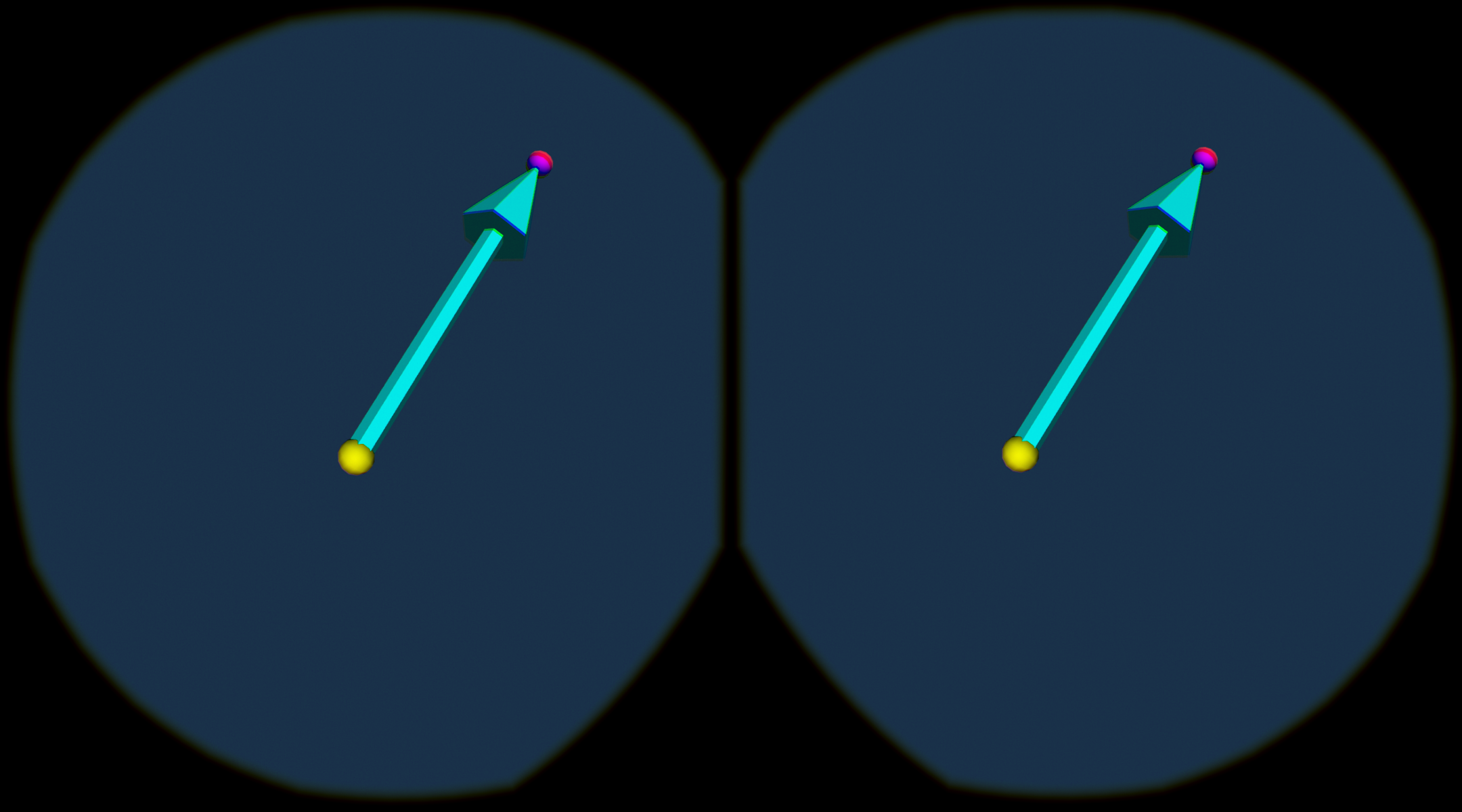OpenVROrientedArrow
Repository source: OpenVROrientedArrow
Description¶
VTK + OpenVR OrientedArrow example.
Note that for the interactions to work in VTK >= 9.1, you will have to copy the .json manifest files from the subfolder Rendering/OpenVR in VTK's source to the working directory in which the tests are run!
Question
If you have a question about this example, please use the VTK Discourse Forum
Code¶
OpenVROrientedArrow.cxx
#include <vtkActor.h>
#include <vtkArrowSource.h>
#include <vtkMath.h>
#include <vtkMinimalStandardRandomSequence.h>
#include <vtkNamedColors.h>
#include <vtkNew.h>
#include <vtkOpenVRRenderWindow.h>
#include <vtkOpenVRRenderWindowInteractor.h>
#include <vtkOpenVRRenderer.h>
#include <vtkPolyData.h>
#include <vtkPolyDataMapper.h>
#include <vtkProperty.h>
#include <vtkSphereSource.h>
#include <vtkTransform.h>
#include <vtkTransformPolyDataFilter.h>
#include <array>
#define USER_MATRIX
int main(int, char*[])
{
vtkNew<vtkNamedColors> colors;
// Set the background color.
std::array<unsigned char, 4> bkg{{26, 51, 77, 255}};
colors->SetColor("BkgColor", bkg.data());
// Create an arrow.
vtkNew<vtkArrowSource> arrowSource;
// Generate a random start and end point
double startPoint[3];
double endPoint[3];
vtkNew<vtkMinimalStandardRandomSequence> rng;
rng->SetSeed(8775070); // For testing.
for (auto i = 0; i < 3; ++i)
{
rng->Next();
startPoint[i] = rng->GetRangeValue(-10, 10);
rng->Next();
endPoint[i] = rng->GetRangeValue(-10, 10);
}
// Compute a basis
double normalizedX[3];
double normalizedY[3];
double normalizedZ[3];
// The X axis is a vector from start to end
vtkMath::Subtract(endPoint, startPoint, normalizedX);
double length = vtkMath::Norm(normalizedX);
vtkMath::Normalize(normalizedX);
// The Z axis is an arbitrary vector cross X
double arbitrary[3];
for (auto i = 0; i < 3; ++i)
{
rng->Next();
arbitrary[i] = rng->GetRangeValue(-10, 10);
}
vtkMath::Cross(normalizedX, arbitrary, normalizedZ);
vtkMath::Normalize(normalizedZ);
// The Y axis is Z cross X
vtkMath::Cross(normalizedZ, normalizedX, normalizedY);
vtkNew<vtkMatrix4x4> matrix;
// Create the direction cosine matrix
matrix->Identity();
for (auto i = 0; i < 3; i++)
{
matrix->SetElement(i, 0, normalizedX[i]);
matrix->SetElement(i, 1, normalizedY[i]);
matrix->SetElement(i, 2, normalizedZ[i]);
}
// Apply the transforms
vtkNew<vtkTransform> transform;
transform->Translate(startPoint);
transform->Concatenate(matrix);
transform->Scale(length, length, length);
// Transform the polydata
vtkNew<vtkTransformPolyDataFilter> transformPD;
transformPD->SetTransform(transform);
transformPD->SetInputConnection(arrowSource->GetOutputPort());
// Create a mapper and actor for the arrow
vtkNew<vtkPolyDataMapper> mapper;
vtkNew<vtkActor> actor;
#ifdef USER_MATRIX
mapper->SetInputConnection(arrowSource->GetOutputPort());
actor->SetUserMatrix(transform->GetMatrix());
#else
mapper->SetInputConnection(transformPD->GetOutputPort());
#endif
actor->SetMapper(mapper);
actor->GetProperty()->SetColor(colors->GetColor3d("Cyan").GetData());
// Create spheres for start and end point
vtkNew<vtkSphereSource> sphereStartSource;
sphereStartSource->SetCenter(startPoint);
sphereStartSource->SetRadius(0.8);
vtkNew<vtkPolyDataMapper> sphereStartMapper;
sphereStartMapper->SetInputConnection(sphereStartSource->GetOutputPort());
vtkNew<vtkActor> sphereStart;
sphereStart->SetMapper(sphereStartMapper);
sphereStart->GetProperty()->SetColor(colors->GetColor3d("Yellow").GetData());
vtkNew<vtkSphereSource> sphereEndSource;
sphereEndSource->SetCenter(endPoint);
sphereEndSource->SetRadius(0.8);
vtkNew<vtkPolyDataMapper> sphereEndMapper;
sphereEndMapper->SetInputConnection(sphereEndSource->GetOutputPort());
vtkNew<vtkActor> sphereEnd;
sphereEnd->SetMapper(sphereEndMapper);
sphereEnd->GetProperty()->SetColor(colors->GetColor3d("Magenta").GetData());
// Create a renderer, render window, and interactor
vtkNew<vtkOpenVRRenderer> renderer;
vtkNew<vtkOpenVRRenderWindow> renderWindow;
renderWindow->Initialize();
renderWindow->AddRenderer(renderer);
renderWindow->SetWindowName("OpenVROrientedArrow");
vtkNew<vtkOpenVRRenderWindowInteractor> renderWindowInteractor;
renderWindowInteractor->SetRenderWindow(renderWindow);
// Add the actor to the scene
renderer->AddActor(actor);
renderer->AddActor(sphereStart);
renderer->AddActor(sphereEnd);
renderer->SetBackground(colors->GetColor3d("BkgColor").GetData());
// Render and interact
renderWindow->Render();
renderWindowInteractor->Start();
return EXIT_SUCCESS;
}
CMakeLists.txt¶
cmake_minimum_required(VERSION 3.12 FATAL_ERROR)
project(OpenVROrientedArrow)
find_package(VTK COMPONENTS
CommonColor
CommonCore
CommonDataModel
CommonTransforms
FiltersGeneral
FiltersSources
InteractionStyle
RenderingContextOpenGL2
RenderingCore
RenderingFreeType
RenderingGL2PSOpenGL2
RenderingOpenGL2
RenderingOpenVR
)
if (NOT VTK_FOUND)
message(FATAL_ERROR "OpenVROrientedArrow: Unable to find the VTK build folder.")
endif()
# Prevent a "command line is too long" failure in Windows.
set(CMAKE_NINJA_FORCE_RESPONSE_FILE "ON" CACHE BOOL "Force Ninja to use response files.")
add_executable(OpenVROrientedArrow MACOSX_BUNDLE OpenVROrientedArrow.cxx )
target_link_libraries(OpenVROrientedArrow PRIVATE ${VTK_LIBRARIES}
)
# vtk_module_autoinit is needed
vtk_module_autoinit(
TARGETS OpenVROrientedArrow
MODULES ${VTK_LIBRARIES}
)
Download and Build OpenVROrientedArrow¶
Click here to download OpenVROrientedArrow and its CMakeLists.txt file. Once the tarball OpenVROrientedArrow.tar has been downloaded and extracted,
cd OpenVROrientedArrow/build
If VTK is installed:
cmake ..
If VTK is not installed but compiled on your system, you will need to specify the path to your VTK build:
cmake -DVTK_DIR:PATH=/home/me/vtk_build ..
Build the project:
make
and run it:
./OpenVROrientedArrow
WINDOWS USERS
Be sure to add the VTK bin directory to your path. This will resolve the VTK dll's at run time.
